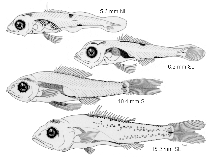| Myomeres 28-30 (usually 30; 9+21 in preflexion stage, 13+17 in postflexion stage); pectorals=15-17 (usually 16, complete in postflexion stage); eye slightly smaller compared with M. parvus; pelvics pigment (when present) usually on distal half of fin before about 16 mm; pigment always present on dorsal and ventral margins.
Patches and bands of pigments; 2nd or 3rd dorsal ray elongate (until 5-10 mm SL); pelvics: (2-10 mm SL) develop rapidly and are long, fragile, and pigmented; distinguished from Sebastolobus spp. at sizes <5 mm SL by: postanal pigment band more anterior, beginning at myomere 15; precocious development of pelvic fin.
Pigmentation:
Yolk-sac-preflexion: on dorsal margin at myomeres 12-13 through 15-19 and on ventral margin at myomeres 13 through 16-17 (16-18 through 19-22 by 5 mm); on yolk; dorsally on gut; distally on pelvic fins, often absent after 4 mm; under hindbrain at 4 mm, spreading onto dorsum by 4.5 mm; posteriorly over midbrain at 4.5 mm.
Flexion-postflexion: increasing over brain; row on each side of dorsal fin base; extending onto caudal peduncle after 7 mm; double row along ventral margin after 7 mm; between hypurals 2-3 by 5.7 mm; bar over hypural area by 9-11mm, spreading forward as dorso- and ventrolateral stripes by about 15 mm; increasing on gut; usually distally on pelvic fins after 6 mm, covering fin after about 16 mm; internally over notochord in postflexion stage (difficult to see).
Transformation: completely pigmented except little or none on pelvic fin and caudal fin rays; gut darkest.
Sequence of fin development: pelvics, dorsal, caudal, pectorals, anal. |
